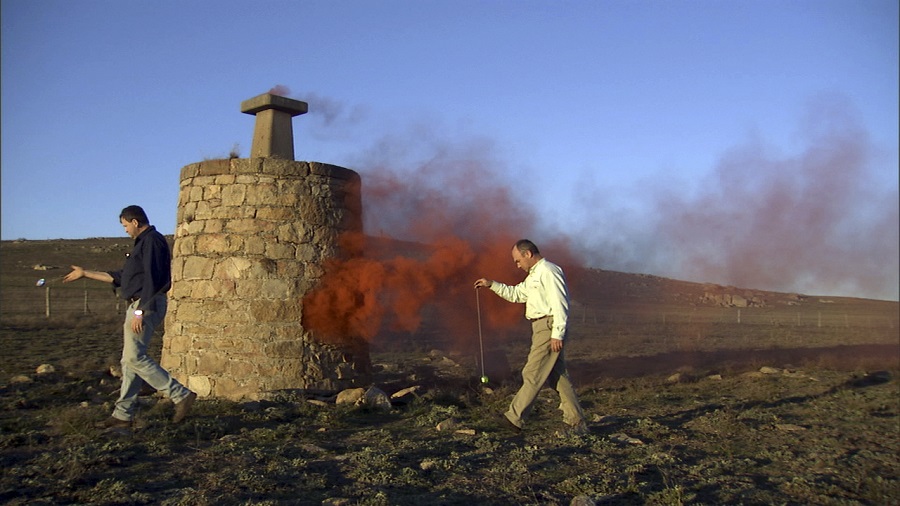Kershaw conceives participation as a productive entity in itself. Both subject and object are defined through the “doing” of artistic praxis.
A Lake Without Water (2005 – 2006), Alex Kershaw – Director/Producer, Scott Otto Anderson – Creative Collaborator, Gail Priest – Sound Design, Video still from 8 channel installation, DVCPRO / DVD, Duration: 3:52
ALEX KERSHAW (NSW)
Born Sydney, NSW, Lives and works Sydney, NSW
Alex Kershaw uses video and photography as a way of mediating intercultural exchange with different people and communities. The work is always carried out in a specific place. In this process, everyday people become participants and collaborators in the production of the work. In “A Lake Without Water” (2006) Kershaw used Lake George in the Australian Capital Territory as a theatre for setting different acts of play in motion. The performances function as circuit breakers within the daily routines of work in and around the lake. “Surveyors, auctioneers and farmers are usually responsible for the reduction of landscape into exchangeable symbolic forms such as maps, law and currency,” he says. “In 'A Lake Without Water', however, they are recast into slapstick style performances, ludic monologues, and uncanny documents.” Rather than recording ‘reality’ as it is given, or manufacturing fictions, Kershaw provokes an alternative reality that is then documented. As a result, his stylistic approach shifts between different genres: performative, cinematic and ‘ethnographic’.
Quotidian rituals become strategies to connect, to cope, and to acculturate. They provide the subject matter for developing the choreography of people’s individual ‘performances’. The camera becomes a way of thinking–negotiating the lived experience of Kershaw’s participants and his artistic re–imagining of place. Travel informs much of Kershaw‘s work. In “The Phi Ta Khon Project” (2009) he went to Dansai in Thailand and created a “magical realist” project that centred on the annual Phi Ta Khon festival combining animist, Brahmin, and Buddhist traditions. By contrast, “One of Several Centres” (2010) emerged from performative interactions between the people who live, work and holiday in Alice Springs. In this work, a series of intimate video engagements reveal the ways people create, acculturate, and cope within the town. Disparate voices are drawn together as a way of unravelling complex spaces that exist in between our standard assumptions of Australia’s “centre”. Through the use of purposefully ambiguous video documents the boundary between truth and invention is blurred, allowing the town to be re- imagined.
Kershaw conceives participation as a productive entity in itself. Both subject and object are defined through the “doing” of artistic praxis. In his work, the amalgam of fact and fiction, the rational and the libidinal is not necessarily a substitution of one–for–the–other. Both are kept in play. This results in the production of a different kind of reality that could equally be a variation of realism or a “new imaginary”. In this process, where meaning is provoked and implicated for his audience, participants are re–embodied within their own surroundings. Their perspectives shift. Their relationship to place is revitalised. Future projects and residencies will build on all these methodologies creating what he has described as “a mobius strip – where participants, their community and the artwork continually turn in on each other.”
Text by Dr Peter Hill, artist and writer and Adjunct Professor of Fine Art at RMIT University, Melbourne.
2011 Anne & Gordon Samstag International Visual Art Scholarship
2010 Masters of Fine Art, College of Fine Arts, University of New South Wales
2000 Bachelor of Fine Arts (Honours), College of Fine Arts, University of New South Wales
Artist's website: www.alexkershaw.com.au

